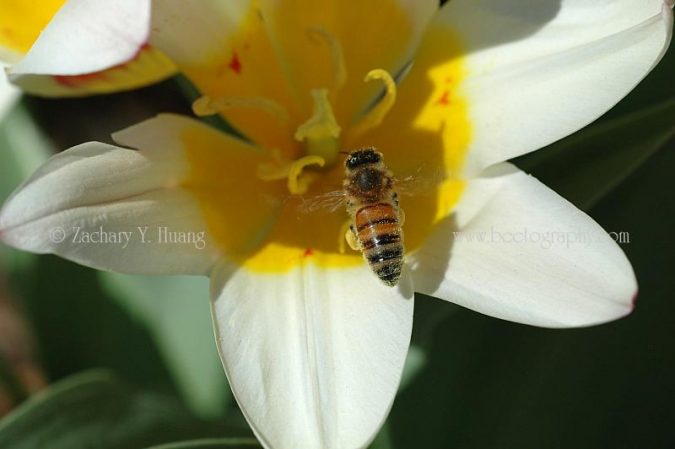| Family | Liliaceae |
| Genus | Tulipa |
| Species | T. gesneriana |
| ZBAS | 7 (for this variety only), 0.1 for others |
Will honey bees forage on tulip flowers? On certain varieties, yes. I searched for google images and there are only a few (less than 4) photos of honey bees foraging on tulips. I have seen others occasionally showing a honey bee flying toward some tulip flowers. Kathy Keatley Garvey says perhaps the lone bee she observed on a tulip was making a mistake. I did observed one variety of tulip attracting many bees — perhaps due to its quite abundant and drier pollen? That was April 11, 2004 (I love digital cameras! on film I am not sure if I would find my record of the date and time). Since tulips are just blooming now, this is another piece of evidence that this year our season is one month behind!
Cultivated tulips (Tulipa gesneriana) synthesize two antimicrobial glycosides, tuliposide A and B. These two chemicals then become lactonized and become tulipalin A and B, respectively. Some people are allergic to tuliposide A. So I hope bees do not collect too many tulip pollen!
There are not many records of honey bees foraging on tulips. So I consider this flower not important for honey bees. Nevertheless, enjoy these flowers, as these bees certainly did!
Photos taken April 11, 2004, with Nikon D70 and Nikkor micro 60mm lens.
1. I was told this type of tulips, with their petals more open (rather than a wine glass) is a more primitive type.
2. You can see the dried pollen on the petals. 3. A bee in flight, she is covered with pollen
3. One is working hard with another one coming to the same flower.
4. Looked at the pollen everywhere!
5. A close up of a bee in flight. the wings are almost vertical, this is during the position when the wings have reached the highest position and the wings are ready to turn direction and then flip downward to generate lift.
References:
Garvey,K.K. 2010. Tiptoeing Through the Tulips,http://cagardenweb.ucanr.edu/?blogpost=2555&blogasset=42184
Shouji, K. 2003. Antimicrobial Activities of Anthers in Tulips. http://abstracts.aspb.org/pb2003/public/P36/0081.html. Accessed May 8, 2014.
Posted May 8, 2014.
Updated June 2, 2020.


Lovely photos! Thank you! Am not a tulip expert, but is the tulip smaller than average? The species tulips ( ie originally wild tulips) tend to be smaller, with open cups. You can google images of several white ones with yellow centers.
if they are a species tulip, it makes sense that the bees would be most interested. It seems that from a bees point of view, the less overbred the better, as things that may make a tulip prettier to human eyes, may also make them less functional in terms of pollen, easy access for a bee, etc.
Am very interested in supporting pollinators , and have been planning on tracking down some of the rare species daffodils, having heard that while bees avoid most daffodils, the species ones can be favorites.
hope this helps